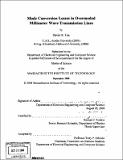Mode conversation losses in overmolded millimeter wave transmission lines
Author(s)
Tax, David S. (David Samuel)
DownloadFull printable version (23.65Mb)
Other Contributors
Massachusetts Institute of Technology. Dept. of Electrical Engineering and Computer Science.
Advisor
Richard J. Temkin.
Terms of use
Metadata
Show full item recordAbstract
Millimeter wave transmission lines are integral components for many important applications like nuclear fusion and NMR spectroscopy. In low loss corrugated transmission lines propagating the HE,1 mode with a high waveguide radius to wavelength ratio (a/X), the transmission line loss is predominantly a result of mode conversion in components such as miter bends. The theory for determining losses in miter bends though is only approximate, and is based instead on the problem of the loss across a diameter-length gap between two waveguide sections. Through simulation, we verified that the existing analytic theory of this gap loss is correct; however, our simulations could not verify the assumption that the miter bend loss is half the loss in the gap. We also considered the problem of higher order modes (HOMs) mixed with an HE11 input entering the miter bend. Using a numerical technique, we found that the loss through the miter bend is dependent on both the amplitude of the HOM content as well as its phase relative to the phase of the HE11 mode. While the overall loss averaged across all phases remains the same with increasing HOM content, the power that fails to traverse the gap tends to increase, and it is this power that appears as very high order modes that will cause heating around the miter bend. For the ITER transmission line, the loss based on gap theory is 0.027 dB and, using a coherent technique, we measured a loss of 0.05 + 0.02 dB with a vector network analyzer (VNA). (cont.) We also set out to measure the mode conversion caused by a miter bend by using a 3-axis scanner system to measure the field patterns within the ITER waveguide. Due to the presence of higher order modes output by the HE I launcher, definitive results on the mode conversion attributed to the miter bend could not be obtained. Using a phase retrieval code, we were able to calculate the mode purity of the launcher output and found it to be 98 + 0.5 %. Future work will concentrate on reducing this HOM content to enable measurements of the miter bend mode conversion.
Description
Thesis (S.M.)--Massachusetts Institute of Technology, Dept. of Electrical Engineering and Computer Science, 2008. Includes bibliographical references (p. 106-109).
Date issued
2008Department
Massachusetts Institute of Technology. Department of Electrical Engineering and Computer SciencePublisher
Massachusetts Institute of Technology
Keywords
Electrical Engineering and Computer Science.